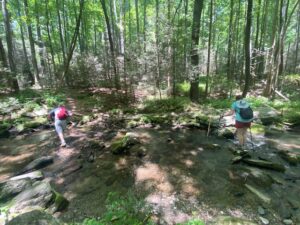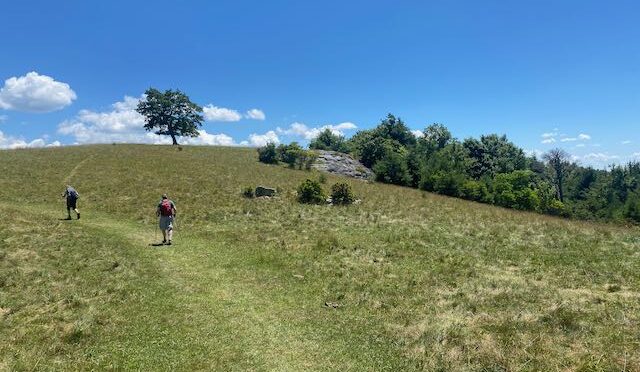We were sitting around what would have been a campfire had it not been 85 degrees, when one of the hikers asked, “How does tomorrow’s hike compare to today’s?”
It was asked with a hint of trepidation. “Today’s” hike — a 6.6-mile out-and-back with just 1,000 feet of elevation gain — was supposed to be the easy one, the warm-up for tomorrow’s 14-miler, which gained nearly 2,400 feet in 4.3 miles. Yet today’s hike had kicked our butts.
I didn’t want to say tomorrow’s hike would be easier, though in a lot if ways, it was. Before I could come up with an explanation, another hiker said, “Because that hike today was hard.”

“It was,” I agreed. “But today’s hike was more of a fits-and-starts hike. Quick climbs, lots of creek crossings. It was was hard to get in a groove.”
“It took a lot of concentration,” Chris said. “And that can be tiring, especially in this heat.”
And that was it! The hike we’d just done may have been shorter, may not have had the elevation. But it also didn’t let you establish something crucial in conquering a long hike: It didn’t let you get into a rhythm.
Rhythm. Mountain bikers refer to it as flow; they rate how good a mountain bike trail is by how it flows. It’s a trail you may work hard on, but a trail that doesn’t constantly remind you you’re working hard. It’s a Zen thing that’s not as consciously recognized in hiking. But it’s definitely there. A trail that has good rhythm is identifiable by several traits:
- Smooth tread. Even a trail that might not seem that rocky and rooty, can have occasional interruptions make you break your rhythm. Just as your cruising along — boom! — you have to pay close attention.
- Steady elevation gains. A big difference between hiking in the East vs. the West is that while the mountains may be bigger out West, the trails have more terrain to climb them, often utilizing sweeping arcs over open mountain. Here, the climbs are dictated by dense forests, outcrops, ravines and other obstacles. Thus, you’ll often find shorter, steeper climbs here. When you find one of those Western-type climbs here, embrace it.
- Minimal stream crossings. Even an easy rock hop will cause you to break stride. If you’re looking to get your hiking groove on, avoid water crossings.
- Few intersecting trails. Even well-marked crossing trails will make you pause to make even a seemingly easy decision on where to go.
- Good scenery, but not great. That is, not a lot of jaw-dropping spots that make you stop in your tracks and, well, drop your jar — and mess up your pace. OK, maybe one jaw-dropper, but not until trail’s end.
- Easy to follow. Not necessarily well-blazed. Blazes help, sure. But they can be infrequent and unreliable. Better is a trail that’s well worn and easy to follow, even on autopilot.
So what trails in these parts let you establish a good hiking rhythm? Come back next week to find out.
